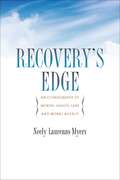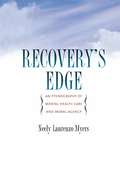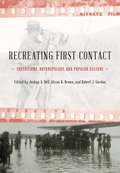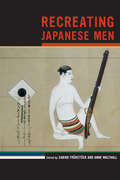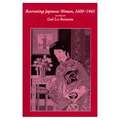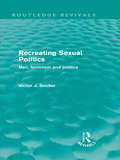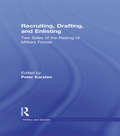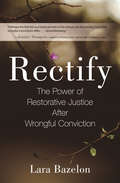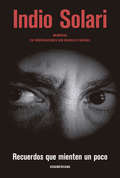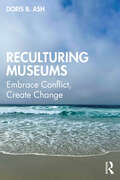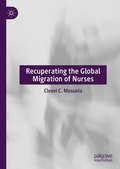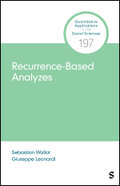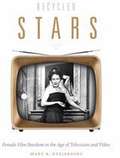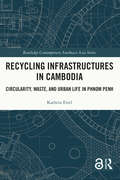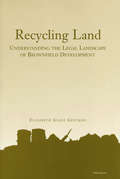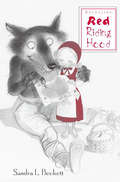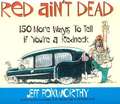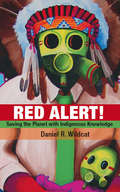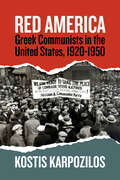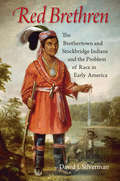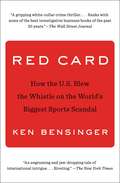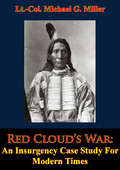- Table View
- List View
Recovery's Edge: An Ethnography Of Mental Health Care And Moral Agency
by Neely Laurenzo MyersIn 2003 the Bush Administration's New Freedom Commission asked mental health service providers to begin promoting "recovery" rather than churning out long-term, "chronic" mental health service users. Recovery's Edge sends us to urban America to view the inner workings of a mental health clinic run, in part, by people who are themselves "in recovery" from mental illness. In this provocative narrative, Neely Myers sweeps us up in her own journey through three years of ethnographic research at this unusual site, providing a nuanced account of different approaches to mental health care. Recovery's Edge critically examines the high bar we set for people in recovery through intimate stories of people struggling to find meaningful work, satisfying relationships, and independent living. This book is a recipient of the Norman L. and Roselea J. Goldberg Prize from Vanderbilt University Press for the best book in the area of medicine.
Recovery's Edge: An Ethnography of Mental Health Care and Moral Agency
by Neely Laurenzo MyersIn 2003 the Bush Administration's New Freedom Commission asked mental health service providers to begin promoting "recovery" rather than churning out long-term, "chronic" mental health service users. Recovery's Edge sends us to urban America to view the inner workings of a mental health clinic run, in part, by people who are themselves "in recovery" from mental illness.In this provocative narrative, Neely Myers sweeps us up in her own journey through three years of ethnographic research at this unusual site, providing a nuanced account of different approaches to mental health care. Recovery's Edge critically examines the high bar we set for people in recovery through intimate stories of people struggling to find meaningful work, satisfying relationships, and independent living.This book is a recipient of the Norman L. and Roselea J. Goldberg Prize from Vanderbilt University Press for the best book in the area of medicine.
Recreating First Contact: Expeditions, Anthropology, and Popular Culture
by Joshua A. Bell Alison K. Brown Robert J. GordonRecreating First Contact explores themes related to the proliferation of adventure travel which emerged during the early twentieth century and that were legitimized by their associations with popular views of anthropology. During this period, new transport and recording technologies, particularly the airplane and automobile and small, portable, still and motion-picture cameras, were utilized by a variety of expeditions to document the last untouched places of the globe and bring them home to eager audiences. These expeditions were frequently presented as first contact encounters and enchanted popular imagination. The various narratives encoded in the articles, books, films, exhibitions and lecture tours that these expeditions generated fed into pre-existing stereotypes about racial and technological difference, and helped to create them anew in popular culture. Through an unpacking of expeditions and their popular wakes, the essays (12 chapters, a preface, introduction and afterward) trace the complex but obscured relationships between anthropology, adventure travel and the cinematic imagination that the 1920s and 1930s engendered and how their myths have endured. The book further explores the effects - both positive and negative - of such expeditions on the discipline of anthropology itself. However, in doing so, this volume examines these impacts from a variety of national perspectives and thus through these different vantage points creates a more nuanced perspective on how expeditions were at once a global phenomenon but also culturally ordered.
Recreating Japanese Men
by Sabine Frühstück Anne WalthallThe essays in this groundbreaking book explore the meanings of manhood in Japan from the seventeenth to the twenty-first centuries. Recreating Japanese Men examines a broad range of attitudes regarding properly masculine pursuits and modes of behavior. It charts breakdowns in traditional and conventional societal roles and the resulting crises of masculinity. Contributors address key questions about Japanese manhood ranging from icons such as the samurai to marginal men including hermaphrodites, robots, techno-geeks, rock climbers, shop clerks, soldiers, shoguns, and more. In addition to bringing historical evidence to bear on definitions of masculinity, contributors provide fresh analyses on the ways contemporary modes and styles of masculinity have affected Japanese men's sense of gender as authentic and stable.
Recreating Japanese Women, 1600-1945
by Gail L. BernsteinIn thirteen wide-ranging essays, scholars and students of Asian and women's studies will find a vivid exploration of how female roles and feminine identity have evolved over 350 years, from the Tokugawa era to the end of World War II. Starting from the premise that gender is not a biological given, but is socially constructed and culturally transmitted, the authors describe the forces of change in the construction of female gender and explore the gap between the ideal of womanhood and the reality of Japanese women's lives. Most of all, the contributors speak to the diversity that has characterized women's experience in Japan. This is an imaginative, pioneering work, offering an interdisciplinary approach that will encourage a reconsideration of the paradigms of women's history, hitherto rooted in the Western experience.
Recreating Sexual Politics: Men, Feminism and Politics (Routledge Revivals)
by Victor SeidlerThis thought-provoking book, first published in 1991, examines sexual politics in a world which is being radically changed by the challenges of feminism. Seidler explores how men have responded to feminism, and the contradictory feelings men have towards dominant forms of masculinity. Seidler’s stimulating and original analysis of social and political theory connects personally to everyday issues in people’s lives. It reflects the growing importance of sexual and personal politics within contemporary politics and culture, and demonstrates clearly the challenge that feminism brings to our inherited forms of morality, politics and sexuality.
Recreation And Leisure In Modern Society
by Amy Hurd Daniel McLean Denise M. AndersonEach new print copy includes Navigate 2 Advantage Access that unlocks a comprehensive and interactive eBook, student practice activities and assessments, a full suite of instructor resources, and learning analytics reporting tools. Reorganized and streamlined to enhance learning outcomes, the eleventh edition of Kraus' Recreation and Leisure in Modern Society provides a detailed introduction to the history, developments, and current trends in leisure studies. The Eleventh Edition focuses on the challenges and opportunities impacting the profession--including dramatic demographic changes, new technologies, and innovations in marketing--through an array of pedagogical features, including engaging sidebars and case studies addressing contemporary issues. Focusing on the ten different types of organizations--ranging from nonprofit community organizations and armed forces recreation to sports management and travel and tourism sponsors--the Eleventh Edition is an invaluable resource for students considering a career in the recreation and leisure industry. With Navigate 2, technology and content combine to expand the reach of your classroom. Whether you teach an online, hybrid, or traditional classroom-based course, Navigate 2 delivers unbeatable value. Experience Navigate 2 today at www.jblnavigate.com/2.
Recruiting International Students in Higher Education
by Sylvie LomerThis book offers a comprehensive overview and critical analysis of the UK's policy on recruiting international students. In a global context of international education policy, it examines changes from New Labour policies under Tony Blair's Prime Minister's Initiative, to the more recent Coalition and Conservative Government policies in the International Education Strategy. The research uses a text-based approach to primary research, adopting a critical framework developed by Carol Bacchi ('what is the problem represented to be'?). The book argues that international student policy can be reduced to reasons for and against recruiting international students; in doing so, students are represented as ambassadors for the UK or tools in its public diplomacy, consumers and generators of reputation, means to get money, and as migrants of questionable legitimacy. These homogenizing representations have the potential to shape international education, implicating academics as agents of policy, and infringing on students' self-formation. The book will be compelling reading for students and researchers in the fields of education and sociology, as well as those interested in education policy-making.
Recruiting, Drafting, and Enlisting: Two Sides of the Raising of Military Forces (Military and Society #Vol. 1)
by Peter KarstenFirst Published in 1999. Routledge is an imprint of Taylor & Francis, an informa company.
Rectify: The Power of Restorative Justice After Wrongful Conviction
by Lara BazelonMakes a powerful argument for adopting a model of restorative justice as part of the Innocence Movement so exonerees, crime victims, and their communities can come together to heal.In Rectify, a former Innocence Project director and journalist Lara Bazelon puts a face to the growing number of men and women exonerated from crimes that kept them behind bars for years - sometimes decades - and that devastate not only the exonerees but also their families, the crime victims who mistakenly identified them as perpetrators, the jurors who convicted them, and the prosecutors who realized too late that they helped convict an innocent person.Bazelon focuses on Thomas Haynesworth, a teenager arrested for multiple rapes in Virginia, and Janet Burke, a rape victim who mistakenly IDed him. It took over two decades before he was exonerated. Conventional wisdom points to an exoneration as a happy ending to tragic tales of injustice, such as Haynesworth's. However, even when the physical shackles are left behind, invisible ones can be profoundly more difficult to unlock.In the midst of Bazelon's frustration over the blatant limitations of courts and advocates, her hope is renewed by the fledgling but growing movement to apply the centuries-old practice of restorative justice to wrongful conviction cases. Using the stories of Thomas Haynesworth, Janet Burke, and other crime victims and exonerees, she demonstrates how the transformative experience of connecting isolated individuals around mutual trauma and a shared purpose of repairing harm unite unlikely allies. Movingly written and vigorously researched, Rectify takes to task the far-reaching failures of our criminal justice system and offers a window into a future where the power it yields can be used in pursuit of healing and unity rather than punishment and blame.
Recuerdos que mienten un poco: Memorias. En conversaciones con Marcelo Figueras
by Indio SolariLas memorias del Indio Solari, creador y líder de Patricio Rey y sus Redonditos de Ricota, desde sus orígenes en Paraná hace 70 años hasta hoy, atravesando la historia de sus bandas disco por disco, sus comienzos, sus influencias, su independencia militante, su compleja relación con los medios, sus polémicas, y su presente personal y artístico. La primera autobiografía completa y en primera persona de Carlos Alberto "El Indio" Solari (Paraná, 1949), fundador junto con Skay Beilinson de Patricio Rey y sus Redonditos de Ricota. Mediante el recorrido de su vida y una obra (sus influencias y sus temas) que lo convirtió en icono de la escena contracultural del rock argentino, nos acercamos al contenido de sus letras y sus melodías, sus ídolos, la relación con su público y con la prensa (su renuencia a aparecer en medios masivos), con sus compañeros de bandas y también con los músicos de su generación. Atravesando su trayectoria junto a los Redondos hasta la disolución en 2001; la historia de los cuatro discos que grabó con su nuevo grupo, Los Fundamentalistas del Aire Acondicionado, y su presente -ahora que ha aceptado hablar públicamente sobre su enfermedad-, el Indio, el artista militante del NO-TELEVISIÓN, lo cuenta todo.
Reculturing Museums: Embrace Conflict, Create Change
by Doris B. AshReculturing Museums takes a unified sociocultural theoretical approach to analyze the many conflicts museums experience in the 21st century. Embracing conflict, Ash asks: What can practitioners and researchers do to create the change they want to see when old systems remain stubbornly in place?Using a unified sociocultural, cultural-historical, activity-theoretical approach to analyzing historically bound conflicts that plague museums, each chapter is organized around a central contradiction, including finances ("Who will pay for museums?"), demographic shifts ("Who will come to museums?"), the roles of narratives ("Whose story is it?"), ownership of objects ("Who owns the artifact?"), and learning and teaching ("What is learning and how can we teach equitably?"). The reculturing stance taken by Ash promotes social justice and equity, ‘making change’ first, within museums, called inreach, rather than outside the museum, called outreach; challenges existing norms; is sensitive to neoliberal and deficit ideologies; and pays attention to the structure agency dialectic.Reculturing Museums will be essential reading for academics, students, museum practitioners, educational researchers, and others who care about museums and want to ensure that all people have equal access to the activities, objects, and ideas residing in them.
Recuperating The Global Migration of Nurses
by Cleovi C. MosuelaSitting at the nexus of labor migration and health care work, this book examines the dynamic relationship between nurses’ cross-border movement and efforts to regulate their migration. Grounded in multi-sited qualitative research, this volume analyzes the changing social dimensions and transnational scale of global nursing, focusing particularly on the recruitment from the Philippines to Germany. The flow of nursing skills from resource-poor countries to well-off ones is not only producing a global care crisis, but also serves as a prime example of the international race for talent and skill. As it takes a critical eye to the emerging field of migration governance or management as the preferred policy response to competing discourses of global care crises and the global competition for skilled care work, this book highlights not only the shifting web of actors, discourses, and practices in care work migration management, but also, and more importantly, how various forms of care figure in the global migration of nurses.
Recurrence-Based Analyses (Quantitative Applications in the Social Sciences)
by Sebastian Wallot Giuseppe LeonardiThis book introduces techniques developed in physics and physiology for characterizing and analyzing patterns in time series data to a broad audience of social scientists. In contrast to time-series regression and related techniques, recurrence quantification analysis (RQA) has its background in chaos and nonlinear dynamical systems—theory arguably very relevant to social processes. The goal of Recurrence-Based Analyses is to introduce readers to these techniques that can characterize a system’s complexity, stability and instability, and conditions under which it transitions from one state to another. The authors illustrate concepts and techniques with relevant social science examples at different temporal scales: biweekly polling data on federal elections in Germany; daily values of three stock market indices; daily cases of SarsCov-19 in four countries during the pandemic; and second-by-second vocalizations of mothers and infants interacting recorded by motion cameras. This introduction to RQA serves as a useful supplement to undergraduate and graduate courses in computational social science, and also by researchers who seek new tools to address social scientific questions in new ways.
Recurrence-Based Analyses (Quantitative Applications in the Social Sciences)
by Sebastian Wallot Giuseppe LeonardiThis book introduces techniques developed in physics and physiology for characterizing and analyzing patterns in time series data to a broad audience of social scientists. In contrast to time-series regression and related techniques, recurrence quantification analysis (RQA) has its background in chaos and nonlinear dynamical systems—theory arguably very relevant to social processes. The goal of Recurrence-Based Analyses is to introduce readers to these techniques that can characterize a system’s complexity, stability and instability, and conditions under which it transitions from one state to another. The authors illustrate concepts and techniques with relevant social science examples at different temporal scales: biweekly polling data on federal elections in Germany; daily values of three stock market indices; daily cases of SarsCov-19 in four countries during the pandemic; and second-by-second vocalizations of mothers and infants interacting recorded by motion cameras. This introduction to RQA serves as a useful supplement to undergraduate and graduate courses in computational social science, and also by researchers who seek new tools to address social scientific questions in new ways.
Recycled Stars: Female Film Stardom in the Age of Television and Video
by Mary R. DesjardinsThe popularity of television in postwar suburban America had a devastating effect on the traditional Hollywood studio system. Yet many aging Hollywood stars used television to revive their fading careers. In Recycled Stars, Mary R. Desjardins examines the recirculation, ownership, and control of female film stars and their images in television, print, and new media. Female stardom, she argues, is central to understanding both the anxieties and the pleasures that these figures evoke in their audiences' psyches through patterns of fame, decline, and return. From Gloria Swanson, Loretta Young, Ida Lupino, and Lucille Ball, who found new careers in early television, to Maureen O'Hara's high-profile 1957 lawsuit against the scandal magazine Confidential, to the reappropriation of iconic star images by experimental filmmakers, video artists, and fans, this book explores the contours of female stars' resilience as they struggled to create new contexts for their waning images across emerging media.
Recycling Infrastructures in Cambodia: Circularity, Waste, and Urban Life in Phnom Penh (Routledge Contemporary Southeast Asia Series)
by Kathrin EitelThis book examines the recycling infrastructure in Phnom Penh, Cambodia. It considers the circular flows of waste and practices through ‘infracycles’, maintenance practices that tinker with the social and capitalist order, and postcolonial ways of doing politics that co-constitute predominant waste fantasies from which naturecultures ooze out, shaping urban life in their own way. In this context, socially marginalized waste pickers contest the capitalist system by creating tropes about freedom, labor autonomy, and the will to survive. In this regard, they are also meddling about a new social order that represents the fine line Cambodia is sashaying between tradition and modernity. Waste fantasies that are a result of environmental problematizations, however, perpetuate postcolonial ways of doing politics by exuding notions of waste as detached from its sociocultural context. But ultimately, waste slips through the cracks of these dominant imaginaries and global waste reduction models enacting new versions of what waste and the city is, providing opportunities for another future waste policy. This book is a unique contribution to the field of infrastructure studies emphasizing the importance of perceiving infrastructure as circular in smaller ‘infracycles’, rather than linear. It will be of interest to researchers in the field of environmental anthropology, science and technology studies, urban studies, and Southeast Asian studies. The Introduction of this book is available for free in PDF format as Open Access from the individual product page at www.routledge.com. It has been made available under a Creative Commons Attribution-Non Commercial-No Derivatives 4.0 license
Recycling Land: Understanding the Legal Landscape of Brownfield Development
by Elizabeth Glass GeltmanOlder--and often economically depressed--industrial cities generally have a number of well located but abandoned industrial sites. Too frequently these sites are heavily polluted by the residue of toxic wastes dumped when old factories were still in use. These "brownfield" sites must be cleaned up under existing law before they can be redeveloped. And yet the question of who will bear the cost of this cleanup frequently stymies efforts to return these sites to productive use. A complicated net of federal, state and local regulations can involve several generations of owners in potential liability for the cleanup, frequently resulting only in extended litigation, not often in the cleanup of the site. In this book, Elizabeth Glass Geltman surveys the laws on both the federal and state level with regard to the cleanup of brownfield sites. The author makes valuable suggestions for reforming these laws that will help encourage land reuse and the accompanying redevelopment of the industrial base of many American cities both large and small. Elizabeth Glass Geltman is Professor of Law, George Washington University Law School and is the author of many books on environmental law, includingModern Environmental Law: Policy and Practice.
Recycling Red Riding Hood (Children's Literature and Culture #Vol. 23)
by Sandra BeckettSandra Beckett's book explores the contemporary retelling of the Red Riding Hood tale in Western children's literature.
Red Ain't Dead: 150 More Ways To Tell If You're A Redneck
by Jeff FoxworthyIt is true, as you may have heard, that a comedian's jokes are like his children. You conceive them (not nearly as much fun as with real kids), nurture them, and eventually let them go. Like real children, some are cute, some are bad, and once in a while one exceeds every expectation you ever had for it. That was the case with my "Redneck" jokes. Appropriately conceived in a cheap motel in Huntsville, Alabama, they quickly grew into more than a comedy bit or even a best-selling book. They became a part of my life. People stop me in airports or on streets and say, "Hey, you're the Redneck guy! And I'm one of 'em!" Excerpts from the first book, YOU MIGHT BE A REDNECK IF..., have been copied, modified, and faxed from workplace to workplace. The material has been "borrowed" by newspapers, wire services, and radio stations nationwide. I feared we had beaten the subject to death, but not a day goes by that someone doesn't offer me a new example of "redneckism." I have received photos of front-yard flower pots made out of old toilets, and newspaper clippings of grooms wearing Harley-Davidson tee-shirts. With the help of my wife and friends, I add several to the list almost daily. I have collected numerous Redneck lines from radio audiences and even from my live show audiences. I must admit that I am very proud of my "Redneck child." I am even happier that others love it as I do. So for all those people, here is a second helping. Though conventional wisdom says you can't believe everything you read, in this case I assure you that you can. Red ain't dead. - Jeff Foxworthy
Red Alert!
by Daniel R. Wildcat"Red Alert! offers insight, hope, and a path forward."--Billy Frank Jr., Chairman, Northwest Indian Fisheries Commission"What the world needs today is a good dose of indigenous realism," says Native American scholar Daniel R. Wildcat in this thoughtful, forward-looking treatise. The Native response to the environmental crisis facing our planet, Red Alert! seeks to debunk our civilization's long-misguided perception that humankind is at odds with nature or that it exerts control over the natural world.Taking a hard look at the biggest problem that we face today--the damaging way we live on this earth--Wildcat draws upon ancient Native American wisdom and nature-centered beliefs to advocate a modern strategy to combat global warming. Inspiring and insightful, Red Alert! is a stirring call to action.Daniel R. Wildcat (Yuchi, Muscogee) is the director of the American Indian studies program and the Haskell Environmental Research Studies Center at Haskell Indian Nations University in Lawrence, Kansas. He is the co-author with Vine Deloria Jr. of Power and Place: Indian Education in America and the co-author of Destroying Dogma: Vine Deloria Jr. and His Influence on American Society.
Red America: Greek Communists in the United States, 1920-1950
by Kostis KarpozilosHistorians of immigration and ethnicity in the United States have typically devoted little attention to Greek Americans, while popular narratives depict them as indifferent or hostile to political and social radicalism. From acclaimed historian Kostis Karpozilos, Red America provides an alternative narrative of the Greek American experience. Focusing on the history of the Greek American Left from the beginning of the twentieth century to the Cold War, this volume uncovers the threads that bound notions of radical social change to everyday immigrant life, tracing ethnic radicalism from the boundaries of a specific community to the epicenter of American social and political history.
Red Brethren: The Brothertown and Stockbridge Indians and the Problem of Race in Early America
by David J. SilvermanNew England Indians created the multitribal Brothertown and Stockbridge communities during the eighteenth century with the intent of using Christianity and civilized reforms to cope with white expansion. In Red Brethren, David J. Silverman considers the stories of these communities and argues that Indians in early America were racial thinkers in their own right and that indigenous people rallied together as Indians not only in the context of violent resistance but also in campaigns to adjust peacefully to white dominion. All too often, the Indians discovered that their many concessions to white demands earned them no relief. In the era of the American Revolution, the pressure of white settlements forced the Brothertowns and Stockbridges from New England to Oneida country in upstate New York. During the early nineteenth century, whites forced these Indians from Oneida country, too, until they finally wound up in Wisconsin. Tired of moving, in the 1830s and 1840s, the Brothertowns and Stockbridges became some of the first Indians to accept U.S. citizenship, which they called "becoming white," in the hope that this status would enable them to remain as Indians in Wisconsin. Even then, whites would not leave them alone. Red Brethren traces the evolution of Indian ideas about race under this relentless pressure. In the early seventeenth century, indigenous people did not conceive of themselves as Indian. They sharpened their sense of Indian identity as they realized that Christianity would not bridge their many differences with whites, and as they fought to keep blacks out of their communities. The stories of Brothertown and Stockbridge shed light on the dynamism of Indians' own racial history and the place of Indians in the racial history of early America.
Red Card: How the U.S. Blew the Whistle on the World's Biggest Sports Scandal
by Ken BensingerThe definitive, shocking account of the FIFA scandal—the biggest international corruption case of recent years, spearheaded by US investigators, involving dozens of countries, and implicating nearly every aspect of the world’s most popular sport, soccer, including its biggest event, the World Cup.The FIFA case began small, boosted by an IRS agent’s review of an American soccer official’s tax returns. But that humble investigation eventually led to a huge worldwide corruption scandal that crossed continents and reached the highest levels of the soccer’s world governing body in Switzerland. In Red Card, Ken Bensinger explores the case, and the personalities behind it, in vivid detail. There’s Chuck Blazer, a high-living soccer dad who ascended to the highest ranks of the sport while creaming millions from its coffers; Jack Warner, a Trinidadian soccer official whose lust for power was matched only by his boundless greed; and the sport’s most powerful man, FIFA president Sepp Blatter, who held on to his position at any cost even as soccer rotted from the inside out. Remarkably, this corruption existed for decades before American law enforcement officials began to secretly dig, finally revealing that nearly every aspect of the planet’s favorite sport was corrupted by bribes, kickbacks, fraud, and money laundering. Not even the World Cup, the most-watched sporting event in history, was safe from the thick web of corruption, as powerful FIFA officials extracted their bribes at every turn. Arriving just in time for the 2018 World Cup, Red Card goes beyond the headlines to bring the real story to light, accompanying the determined American prosecutors and special agents who uncovered what proved to be not only the biggest scandal in sports history, but one of the biggest international corruption cases ever. And it is far from over.
Red Cloud’s War: An Insurgency Case Study For Modern Times
by Lt.-Col. Michael G. MillerThis will be a case study of the little known Fetterman Massacre of 1866. It will look the situation at the time, possible causes, key players, the massacre itself and the aftermath. Similarities to the counterinsurgency in Afghanistan will be noted where applicable throughout this paper. A case will be proposed that the Army was ill prepared for the Indian Wars of the latter 19th Century, just as they were initially ill prepared for an extended Afghanistan Insurgency Campaign. Connections are drawn showing that there were lessons learned in 1866 that are still appropriate today. Familiarity with them, along with other more recent examples, will better prepare the Army to fight counterinsurgencies in the future.
